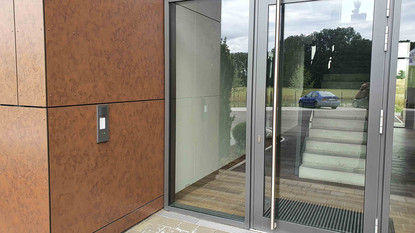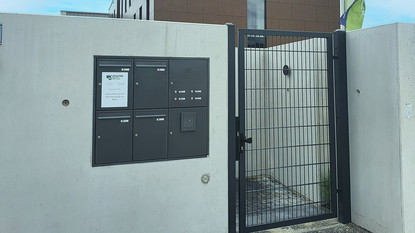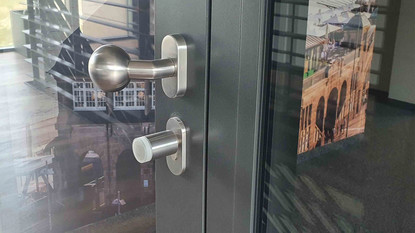Hopfgartner – the plastics specialist
AccessOne from the startHopfgartner Kunststoff- & Umwelttechnik GmbH creates innovative special solutions made of plastic. The company’s bespoke plastic solutions are used in areas where liquids or gases must be captured, collected, cleaned or routed. The Hopfgartner workforce now occupies a new company site at Ilmendorf, near Ingolstadt in Germany, that comprises a large office complex together with production, storage and unheated buildings.

Online access control system and offline locking devices
Not every door in the building requires cabling, yet the operator still expects the highest level of security and ease of use on all its doors.
The economical combination of classic online access control at the external access points with mechatronic offline locking devices for internal doors used for organisational purposes was chosen by the developer of the company premises, Fairnett GmbH & Co. KG.
The three-storey office building situated in Römerstrasse offers plenty of space not only for Hopfgartner but also for three other commercial tenants. The façade of the office complex has a refined, rust-coloured look that makes for an interesting contrast to the exposed concrete of the adjacent production hall.
‘From the genuinely competent advice and project planning, through to the user training and commissioning of the access control system, I have found CES to be a long-term and reliable partner.’
Mario Hopfgartner, Technical Director
Hopfgartner Kunststoff- & Umwelttechnik GmbH
Access control in practice
The system designController in the technical room
The central access controller (also known as the controller) is the heart of the AccessOne system. It is situated in the technical room, at the heart of the building.
The controller maps a large number of different door situations as well as controlling and monitoring the doors. Equipped with an emergency power supply, it operates autonomously in the event of a server or network failure, continuing to function without interruption.
Access points managed by the software
Individual access rights for all of the doors, personnel access gates and roller doors are defined and managed within the access management software.
Additionally, the software offers numerous function extensions, including:
- Multi-Client function
- Time registration
- Visitor administration
Update readers: always up-to-date
To enter the building, an employee holds their RFID card in front of the Update-Terminal. The authorisations on this identification medium are checked and updated in an instant.
The cabled update readers are positioned at the entrances and constantly exchange with the controller via a data cable. Integrated into the Siedle Vario housing, they are linked to the intercom system.
ID card security
MIFARE® DESFire
The information exchange between the cabled access control system and mechatronic offline locking devices is effected via the ID cards. These are equipped with high-security MIFARE® DESFire RFID locking media technology.
Lost ID cards marked and blocked
Even if an ID card is reported as lost, authorisations for that ID card can be instantly cancelled by marking it as blocked in the software. All other ID cards also receive information about the lost ‘colleague’ from the update readers and pass this to the doors in the building. The security of the rented areas is thus defined right from the access points.
Economical access solution for internal doors
Mechatronic locking cylindersThe newly occupied premises of the plastics manufacturer are generously spread over three floors. The reception, archive, foreman’s office, changing area and common room, plus the technical, server and cleaning areas are all on the ground floor. The two upper floors comprise offices, a kitchen, meeting rooms and the offices for the management and secretaries.
These doors are secured with mechatronic locking cylinders. Following their initial basic programming, these locking devices do not need to be individually sought out for reprogramming – even if the purpose of the room is changed. A decisive time and cost advantage for the operator.


